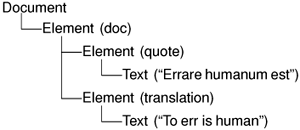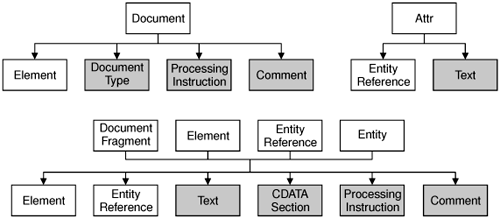Reading XML with DOM
DOM is a standard API for parsing XML developed by the World Wide Web Consortium (W3C). Qt provides a non-validating DOM Level 2 implementation for reading, manipulating, and writing XML documents.
DOM represents an XML file as a tree in memory. We can navigate through the DOM tree as much as we want, and we can modify the tree and save it back to disk as an XML file.
Let's consider the following XML document:
Errare humanum est To err is human
It corresponds to the following DOM tree:

The DOM tree contains nodes of different types. For example, an Element node corresponds to an opening tag and its matching closing tag. The material that falls between the tags appears as child nodes of the Element node.
In Qt, the node types (like all other DOM-related classes) have a QDom prefix. Thus, QDomElement represents an Element node, and QDomText represents a Text node.
Different types of nodes can have different kinds of child nodes. For example, an Element node can contain other Element nodes, and also EntityReference, Text, CDATASection, ProcessingInstruction, and Comment nodes. Figure 14.3 specifies which nodes can have which kinds of child nodes. The nodes shown in gray cannot have any child nodes of their own.
Figure 14.3. Parentchild relationships between DOM nodes

To illustrate how to use DOM for reading XML files, we will write a parser for the book index file format described in the previous section (p. 308).
class DomParser
{
public:
DomParser(QIODevice *device, QListView *view);
private:
void parseEntry(const QDomElement &element,
QListViewItem *parent);
QListView *listView;
};
We define a class called DomParser that will parse a book index XML document and display the result in a QListView. The class does not inherit from any other class.
DomParser::DomParser(QIODevice *device, QListView *view)
{
listView = view;
QString errorStr;
int errorLine;
int errorColumn;
QDomDocument doc;
if (!doc.setContent(device, true, &errorStr, &errorLine,
&errorColumn)) {
qWarning("Line %d, column %d: %s", errorLine, errorColumn,
errorStr.ascii());
return;
}
QDomElement root = doc.documentElement();
if (root.tagName() != "bookindex") {
qWarning("The file is not a bookindex file");
return;
}
QDomNode node = root.firstChild();
while (!node.isNull()) {
if (node.toElement().tagName() == "entry")
parseEntry(node.toElement(), 0);
node = node.nextSibling();
}
}
In the constructor, we create a QDomDocument object and call setContent() on it to have it read the XML document provided by the QIODevice. The setContent() function automatically opens the device if it isn't already open. Then we call documentElement() on the QDomDocument to obtain its single QDomElement child, and we check that it is a element. Then we iterate over all the child nodes, and if the node is an element, we call parseEntry() to parse it.
The QDomNode class can store any type of node. If we want to process a node further, we must first convert it to the right data type. In this example, we only care about Element nodes, so we call toElement() on the QDomNode to convert it to a QDomElement and then call tagName() to retrieve the element's tag name. If the node is not of type Element, the toElement() function returns a null QDomElement object, with an empty tag name.
void DomParser::parseEntry(const QDomElement &element,
QListViewItem *parent)
{
QListViewItem *item;
if (parent) {
item = new QListViewItem(parent);
} else {
item = new QListViewItem(listView);
}
item->setOpen(true);
item->setText(0, element.attribute("term"));
QDomNode node = element.firstChild();
while (!node.isNull()) {
if (node.toElement().tagName() == "entry") {
parseEntry(node.toElement(), item);
} else if (node.toElement().tagName() == "page") {
QDomNode childNode = node.firstChild();
while (!childNode.isNull()) {
if (childNode.nodeType() == QDomNode::TextNode) {
QString page = childNode.toText().data();
QString allPages = item->text(1);
if (!allPages.isEmpty())
allPages += ", ";
allPages += page;
item->setText(1, allPages);
break;
}
childNode = childNode.nextSibling();
}
}
node = node.nextSibling();
}
}
In parseEntry(), we create a QListView item. If the tag is nested within another tag, the new tag defines a subentry in the index, and we create the QListViewItem as a child of the QListViewItem that represents the encompassing entry. Otherwise, we create the QListViewItem with listView as its parent, making it a top-level item. We call setOpen(true) on the item to ensure that any subentries will be visible, and call setText() to set the text shown in column 0 to the value of the tag's term attribute.
Once we have initialized the QListViewItem, we iterate over the child nodes of the QDomElement node corresponding to the current tag.
If the element is , we call parseEntry() with the current item as the second argument. The new entry's QListViewItem will then be created with the encompassing entry's QListViewItem as its parent.
If the element is , we navigate through the element's child list to find a Text node. Once we have found it, we call toText() to convert it to a QDomText object, and data() to extract the text as a QString. Then we add the text to the comma-separated list of page numbers in column 1 of the QListViewItem.
Let's now see how we can use the DomParser class to parse a file:
void parseFile(const QString &fileName)
{
QListView *listView = new QListView(0);
listView->setCaption(QObject::tr("DOM Parser"));
listView->setRootIsDecorated(true);
listView->setResizeMode(QListView::AllColumns);
listView->addColumn(QObject::tr("Terms"));
listView->addColumn(QObject::tr("Pages"));
listView->show();
QFile file(fileName);
DomParser(&file, listView);
}
We start by setting up a QListView. Then we create a QFile and a DomParser. When the DomParser is constructed, it parses the file and populates the list view.
As the example illustrates, navigating through a DOM tree can be cumber-some. Simply extracting the text between and required us to iterate through a list of QDomNodes using firstChild() and nextSibling(). Programmers who use DOM a lot often write their own higher level wrapper functions to simplify commonly needed operations, such as extracting the text between tags.
Part I: Basic Qt
Getting Started
Creating Dialogs
- Creating Dialogs
- Subclassing QDialog
- Signals and Slots in Depth
- Rapid Dialog Design
- Shape-Changing Dialogs
- Dynamic Dialogs
- Built-in Widget and Dialog Classes
Creating Main Windows
- Creating Main Windows
- Subclassing QMainWindow
- Creating Menus and Toolbars
- Implementing the File Menu
- Setting Up the Status Bar
- Using Dialogs
- Storing Settings
- Multiple Documents
- Splash Screens
Implementing Application Functionality
- Implementing Application Functionality
- The Central Widget
- Subclassing QTable
- Loading and Saving
- Implementing the Edit Menu
- Implementing the Other Menus
- Subclassing QTableItem
Creating Custom Widgets
- Creating Custom Widgets
- Customizing Qt Widgets
- Subclassing QWidget
- Integrating Custom Widgets with Qt Designer
- Double Buffering
Part II: Intermediate Qt
Layout Management
- Layout Management
- Basic Layouts
- Splitters
- Widget Stacks
- Scroll Views
- Dock Windows
- Multiple Document Interface
Event Processing
- Event Processing
- Reimplementing Event Handlers
- Installing Event Filters
- Staying Responsive During Intensive Processing
2D and 3D Graphics
Drag and Drop
Input/Output
- Input/Output
- Reading and Writing Binary Data
- Reading and Writing Text
- Handling Files and Directories
- Inter-Process Communication
Container Classes
Databases
Networking
XML
- XML
- Reading XML with SAX
- Reading XML with DOM
- Writing XML
Internationalization
- Internationalization
- Working with Unicode
- Making Applications Translation-Aware
- Dynamic Language Switching
- Translating Applications
Providing Online Help
- Providing Online Help
- Tooltips, Status Tips, and Whats This? Help
- Using QTextBrowser as a Simple Help Engine
- Using Qt Assistant for Powerful Online Help
Multithreading
- Multithreading
- Working with Threads
- Communicating with the GUI Thread
- Using Qts Classes in Non-GUI Threads
Platform-Specific Features
EAN: 2147483647
Pages: 140
